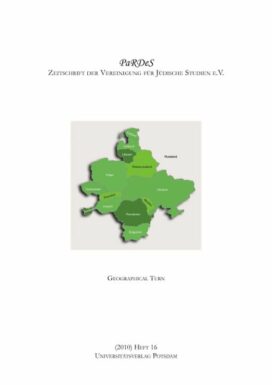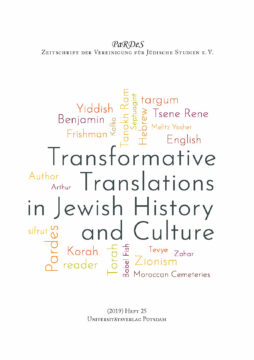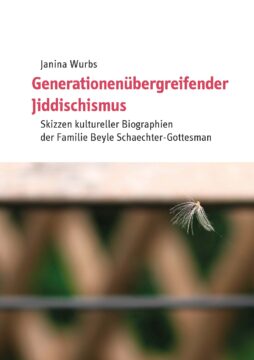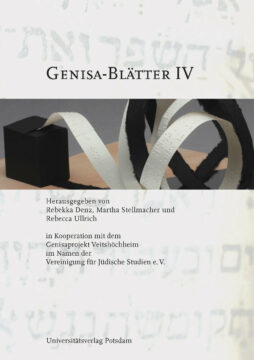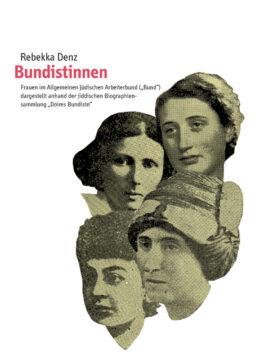Rebekka Denz, Rafael Arnold , Silviu Costachie, Michael Dallapiazza, Anat Feinberg, Elvira Grözinger, Karl Erich Grözinger, William Hiscott, Per Jegebäck, Grazyna Jurewicz, Daniel Jütte, Robert Jütte, Elena Keidosiute, Ulrich Knufinke, Stefan Lang, Joanna Lisek, Diana I. Popescu, Maria Radosav, Ingedore Rüdlin, Anna Rutkowski, Peter Salner, Michael K. Schulz, Suanne Talabardon, Tamas Visi, Kerry Wallach
Rebekka Denz; Grazyna Jurewicz (eds.)
ISBN: 978-3-86956-055-7
265 pages
Release year 2010
Series: PaRDeS : Zeitschrift der Vereinigung für Jüdische Studien e.V. , 16
8,00 €
Non-taxable transaction according to § 1 (1) UStG/VAT Act in combination with § 2 (3) UStG/VAT Act a. F. Providing this service, the University of Potsdam does not constitute a Betrieb gewerblicher Art/Commercial Institution according to § 1 (1) No. 6 or § 4 KStG/Corporate Tax Act. If the legal characterization of our business is changed to a commercial institution subsequently, we reserve the right to invoice VAT additionally. zzgl. Versandkosten
Recommended Books
-
 2019
2019Mirjam Thulin, Markus Krah, Morris M. Faierstein, Danielle Drori, Maria Coors, Netta Schramm, Cory Driver, Gitit Holzman, Ghil‘ad Zuckermann, Eitan P. Fishbane, Caroline Gruenbaum, Sebastian Schirrmeister, Francesco Ferrari, Günter Stemberger, Michaela Schmölz-Häberlein, Judith Müller, Michael K. Schulz, Thomas Meyer, Anna Artwińska, Simon Walter
Transformative Translations in Jewish History and Culture
11,50 €Non-taxable transaction according to § 1 (1) UStG/VAT Act in combination with § 2 (3) UStG/VAT Act a. F. Providing this service, the University of Potsdam does not constitute a Betrieb gewerblicher Art/Commercial Institution according to § 1 (1) No. 6 or § 4 KStG/Corporate Tax Act. If the legal characterization of our business is changed to a commercial institution subsequently, we reserve the right to invoice VAT additionally.
zzgl. Versandkosten
Add to cart -
 2018
2018Generationenübergreifender Jiddischismus
9,50 €Non-taxable transaction according to § 1 (1) UStG/VAT Act in combination with § 2 (3) UStG/VAT Act a. F. Providing this service, the University of Potsdam does not constitute a Betrieb gewerblicher Art/Commercial Institution according to § 1 (1) No. 6 or § 4 KStG/Corporate Tax Act. If the legal characterization of our business is changed to a commercial institution subsequently, we reserve the right to invoice VAT additionally.
zzgl. Versandkosten
Add to cart -
 2023
2023Rebekka Denz, Martha Stellmacher, Rebecca Ullrich, Jael Andra Benar, Lenka Uličná, Annett Martini, Rechal Allgaier-Honal, Isidoro Abramowicz, Neri Ariel, Maria Stürzebecher, Beate Weinhold, Elisabeth Singer-Brehm
Genisa-Blätter IV
16,00 €Non-taxable transaction according to § 1 (1) UStG/VAT Act in combination with § 2 (3) UStG/VAT Act a. F. Providing this service, the University of Potsdam does not constitute a Betrieb gewerblicher Art/Commercial Institution according to § 1 (1) No. 6 or § 4 KStG/Corporate Tax Act. If the legal characterization of our business is changed to a commercial institution subsequently, we reserve the right to invoice VAT additionally.
zzgl. Versandkosten
Add to cart -
 2009
2009Bundistinnen
10,00 €Non-taxable transaction according to § 1 (1) UStG/VAT Act in combination with § 2 (3) UStG/VAT Act a. F. Providing this service, the University of Potsdam does not constitute a Betrieb gewerblicher Art/Commercial Institution according to § 1 (1) No. 6 or § 4 KStG/Corporate Tax Act. If the legal characterization of our business is changed to a commercial institution subsequently, we reserve the right to invoice VAT additionally.
zzgl. Versandkosten
Add to cart
Publisher Info
Contact
Potsdam University Library
University Press
Am Neuen Palais 10
14476 Potsdam
Germany
verlag@uni-potsdam.de
0331 977-2094
0331 977-2292

